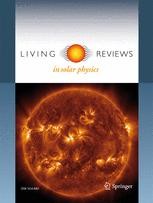Living Reviews in Solar Physics: "Solar force-free magnetic fields"
 Wiegelmann, T., Sakurai, T.: Solar force-free magnetic fields. Living Rev Sol Phys 18, 1 (2021). https://doi.org/10.1007/s41116-020-00027-4
Wiegelmann, T., Sakurai, T.: Solar force-free magnetic fields. Living Rev Sol Phys 18, 1 (2021). https://doi.org/10.1007/s41116-020-00027-4
Open Access | Review Article
Published: 2 March 2021
Major update of Living Rev Sol Phys 9, 5 (2012)
Abstract:
The structure and dynamics of the solar corona is dominated by the magnetic field. In most areas in the corona magnetic forces are so dominant that all non-magnetic forces such as plasma pressure gradients and gravity can be neglected in the lowest order. This model assumption is called the force-free field assumption, as the Lorentz force vanishes. This can be obtained by either vanishing electric currents (leading to potential fields) or the currents are co-aligned with the magnetic field lines. First we discuss a mathematically simpler approach that the magnetic field and currents are proportional with one global constant, the so-called linear force-free field approximation. In the generic case, however, the relationship between magnetic fields and electric currents is nonlinear and analytic solutions have been only found for special cases, like 1D or 2D configurations. For constructing realistic nonlinear force-free coronal magnetic field models in 3D, sophisticated numerical computations are required and boundary conditions must be obtained from measurements of the magnetic field vector in the solar photosphere. This approach is currently a large area of research, as accurate measurements of the photospheric field are available from ground-based observatories such as the Synoptic Optical Long-term Investigations of the Sun and the Daniel K. Inouye Solar Telescope (DKIST) and space-born, e.g., from Hinode and the Solar Dynamics Observatory. If we can obtain accurate force-free coronal magnetic field models we can calculate the free magnetic energy in the corona, a quantity which is important for the prediction of flares and coronal mass ejections. Knowledge of the 3D structure of magnetic field lines also help us to interpret other coronal observations, e.g., EUV images of the radiating coronal plasma.
Update details:
In the updated review, we mainly added new material from articles published between 2012 and 2020. We incorporated about 70 additional references and added 6 new figures. In Sect. 2 “Linear force-free fields”, we added new techniques for deducing the optimal value of the linear force-free parameter alpha from coronal and chromospheric observations. In Sect. 4 “Azimuth ambiguity removal and consistency of field measurements”, we added new investigations regarding the influence of noise and spatial resolution on the performance of ambiguity removal techniques and summarized briefly the methods used for data from SDO/HMI. We added also new investigations on computing the Lorentz force from photospheric vector field measurements. In Sect. 6 “Numerical methods for nonlinear force-free fields”, we added advanced methods for computing nonlinear force-free fields in spherical geometry and newly developed techniques to constrain nonlinear force-free models with coronal observations. We added Sect. 7 “Force-free models: Effects, limitations and comparisons” and summarized how various effects influence the performance of nonlinear force-free computations. We also compared magnetic field extrapolations with alternative methods to derive the coronal magnetic field, e.g., with coronal seismology and MHD-models.
